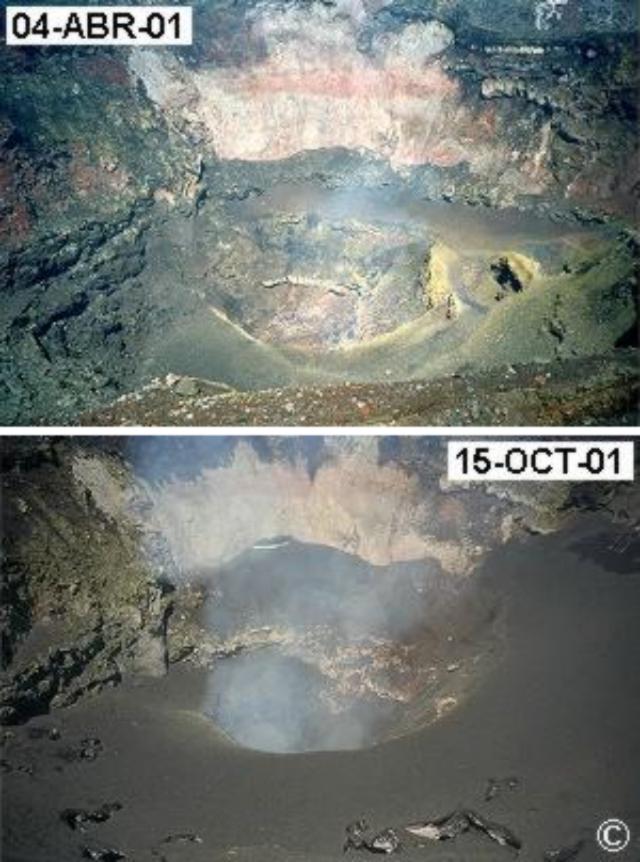Report on Villarrica (Chile) — February 2002
Bulletin of the Global Volcanism Network, vol. 27, no. 2 (February 2002)
Managing Editor: Richard Wunderman.
Villarrica (Chile) Small 14 May eruption; multi-year incandescence; crater visits
Please cite this report as:
Global Volcanism Program, 2002. Report on Villarrica (Chile) (Wunderman, R., ed.). Bulletin of the Global Volcanism Network, 27:2. Smithsonian Institution. https://doi.org/10.5479/si.GVP.BGVN200202-357120
Villarrica
Chile
39.42°S, 71.93°W; summit elev. 2847 m
All times are local (unless otherwise noted)
At Villarrica during 12-29 January 2001, incandescent lava was observed in the crater and ballistics were ejected ~10-30 m. Frequent explosions occurred, accompanied by degassing sounds that continued through February. During 23-29 March, incandescent lava was observed in the inner walls of the chimney to ~80 m depth. Incandescence was observed in the crater throughout April, and ballistics were ejected ~20-110 m as frequently as every 2-10 minutes during mid-April.
The most outstanding event of 2001 occurred on 14 May at around 1445. An eruption that lasted for 3-5 minutes sent a dark column of particles and gases up to ~1.5 km above the volcano. The eruption was presumably of phreatic origin (triggered by magma-water interaction).
After the eruption, observers continued to monitor Villarrica. This report covers crater visits through early August 2001. In addition, this report presents several years of incandescence and associated air-clarity data.
On 19 June, observers noted few changes in the crater compared to an earlier visit on 24 April. The crater floor contained a large opening, a chimney. Incandescence was observed in the opened upper portion of the sub-vertical chimney. The incandescence appeared along the chimney's ENE edge and could be seen to ~80 m depth. The chimney's cross-sectional form was circular, but on this visit it appeared to have shifted slightly toward the N and had increased in diameter (figure 16). Tephra, including ash (diameter under 2 mm) and lapilli (diameter in the range 2-64 mm), was seen scattered over a large area of Villarrica's snow-covered top, indicating recent outbursts and the potential danger of new explosions. During the visit, no fresh lava emerged at the top of the crater during almost 30 minutes of observation.
An interest in assessing the position and state of the lava lake from the vantage of an observation post at distance led workers to devise a means to record incandescence. Two indices were devised to describe conditions seen each night, based on qualitative visual estimates made by an observer 13 km to the NW of the crater. The monthly incandescence glow index (Indice de actividad incandescente mensual, IAIM) furnishes a qualitative estimate of incandescence. The monthly visibility index (IVNM) provides a qualitative estimate of atmospheric visibility (air clarity). For both indices, nightly observations assigned values on a scale from 0-5, and these were averaged for each month. The resulting plot shown here accounted for the number of clear nights each month and translated the axis from the index scale to 0-100 percent. Weather and season influence air clarity, the index for which generally ranged between 25 and 100%.
Figure 17 shows an ~4-year record of these estimates. Both indices showed significant variations, but also suggest a particularly strong rise in incandescence during June 2001. Observations on 19 June revealed fluctuations in degassing and brightness that occurred at ~5- to ~10-minute intervals. Observers noted that local ashfalls took place on 20 and 28 June, depositing zones of ash in the summit area.
A report on a 22 July visit stated that both incandescence and the level of the lava surface were low when compared to 19 June. Noise from degassing was weak. A landslide occurred at the inner edge of the central orifice. Although incandescence had decreased earlier, when visited on 9 August strong degassing occurred, and at 60- to 90-second intervals the chimney ejected ash, lapilli, and bombs (up to 20 cm across) toward the W and SW edges of the crater. Similar eruptions occurred on 16, 17, and 21 August. A 22 August visit revealed that the lava lake had risen ~40 m since 9 August.
In August observers on the crater's edge noted an increase in explosive activity, with ballistic heights of 50-150 m. Some scoriaceous bombs had diameters up to 50 cm.
As of October 2001, the rhythmical eruptions seen during the previous 3 months ceased. Material from those eruptions had formed a carpet of tephra that lay scattered around the chimney with thicknesses up to 15 m in the W part of the crater floor. Figure 7 compares the scene in the crater on 4 April to 15 October.
Incandescent lava was observed in the crater during September 2001 through January 2002, and ballistics were ejected ~80-150 m. Explosions generally occurred every ~1-10 minutes and at times degassing sounds were heard.
Geological Summary. The glacier-covered Villarrica stratovolcano, in the northern Lakes District of central Chile, is ~15 km south of the city of Pucon. A 2-km-wide caldera that formed about 3,500 years ago is located at the base of the presently active, dominantly basaltic to basaltic-andesite cone at the NW margin of a 6-km-wide Pleistocene caldera. More than 30 scoria cones and fissure vents are present on the flanks. Plinian eruptions and pyroclastic flows that have extended up to 20 km from the volcano were produced during the Holocene. Lava flows up to 18 km long have issued from summit and flank vents. Eruptions documented since 1558 CE have consisted largely of mild-to-moderate explosive activity with occasional lava effusion. Glaciers cover 40 km2 of the volcano, and lahars have damaged towns on its flanks.
Information Contacts: Proyecto de Observacion Villarrica (POVI), Wiesenstrasse 8, 86438 Kissing, Germany (URL: http://www.povi.cl/).



